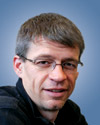 Marc Gallagher
Marc GallagherBuilding a career through deft skill, strong relationships and LEGOs
39, Senior Associate
Langan Engineering and Environmental Services Inc.
New York, N.Y.
Marc Gallagher laid the foundation of his engineering career in the basement of his parents’ house, where he was set loose with LEGO blocks, wood scraps and tools to create ambitious creations.
His engineer father and stay-at-home mom encouraged him to explore the natural world and stressed a balanced academic and athletic life.
A well-rounded background has helped him approach projects with a holistic view, which has earned him assignments on larger projects and brought clients back to the firm. That helped the firm grow from 16 people in 2001 to more than 120 people in 2008.
“We have a people approach to projects,” Gallagher says. “It was an unprecedented boom time, but I was aggressive with personal relationships, meeting people and making projects more than the next paycheck, getting involved in their businesses and what they do. It’s seeing the whole picture, so they realize we are looking out for their best interest. They came to trust us as allies and came back.”
Gallagher credits his rise in the organization in part to the amount of work taking place during that time frame but also to his ability to handle complicated projects, such as stadiums and skyscrapers.
Early on, he joined the ACE Mentor Program to reach out to and help educate young people interested in the design and construction industry.
At home, Gallagher keeps plenty of LEGOs around to pique his daughter’s and son’s interest. He takes pride in showing his children the construction sites and finished buildings he has worked on.
“It feels good to have things like that to show what you do in your life,” he adds.
 Marcos Diaz-Gonzalez
Marcos Diaz-GonzalezBridging the gap between global interests and local execution
38, Vice President
AECOM
New York, N.Y.
Ever since he planted the first seeds of his career, Marcos Diaz-Gonzalez has approached the construction industry from an international perspective.
“You can be global, but at the end of the day most of what we do is delivered locally,” he says. “You have to understand the local culture and customs.”
Born in Spain, Gonzalez studied engineering in his native country before moving to the United States to complete a degree in urban planning at Stanford University in California.
Gonzalez first established himself in New York and abroad as NYC2012’s director of venue planning, involved in the city’s effort to land the 2012 Olympic Games. His role included representing the city and presenting its technical plan to local and international groups, including the International Olympic Committee.
His ability to think globally and execute locally attracted international firm AECOM. In 2005, he joined AECOM to serve as project director for the $1.2-billion redevelopment of Lincoln Center.
In 2010, Gonzalez made his way back to Spain, leading the integration of Spain-based INOCSA, a 550-person high-speed rail engineering company, into AECOM.
 Eli Gottlieb
Eli GottliebYoungest-ever principal at top-tier international engineering firm
36, Principal
Thornton Tomasetti
New York, N.Y.
Eli Gottlieb joined Thornton Tomasetti 14 years ago and has since become the youngest-ever principal at the 550-person firm. He gained diverse experience early, working on technical and creative projects around the world. “I tried to take every opportunity I got and learn from it, and that took me to the path of being principal,” he says.
Gottlieb feels as comfortable with the historic renovation of a cast iron and masonry structure as he does with the design of the latest 60-story commercial tower. He thrives on challenges and relishes the process of applying fundamental mechanics to new materials and applications.
“I tried to take every opportunity I got and learn from it, and that took me to the path of being principal.”
—Eli Gottlieb, 36, Principal, Thornton Tomasetti
Always curious about how things were built, Gottlieb majored in civil engineering and structures and minored in architecture at Princeton University. He later earned a master’s degree at Columbia University. He has taught at both his alma maters and appreciates the opportunity that offers him to challenge issues beyond the norm of commercial practice.
“In the academic world there’s more freedom to think about how to best do something given a different set of parameters from the applied field,” he adds.
Gottlieb brought his creative thinking to a number of projects, such as the 40-story 11 Times Square, in which the concrete core was built before the steel frame—a first for New York.
 Warren Harris
Warren HarrisCaptured a new niche market for a growing geotechnical group
39, Vice President, Dam Safety Services
CHA
Albany, N.Y.
As a teenager, Warren Harris worked as a laborer to help his father rehab two small hydroelectric dams that he had purchased. Decades later, he remains fascinated by them.
“I’ve worked on a lot of [geotechnical engineering] projects, but something about the structures that hold back water has always intrigued me,” he says.
In the 17 years since graduating with a bachelor’s degrees in civil engineering from Rensselaer Polytechnic Institute, Harris has developed a wealth of experience on more than 650 geotechnical engineering projects, including roadway reconstructions, landfill closures, mining plans, foundation reports, deep foundation designs, sheet pile designs, seismic analyses and slope stability analyses.
Although he didn’t know it at the time, Harris’ career took a giant leap forward when CHA was retained to investigate the cause of the failure of the Hadlock Pond Dam in Washington County, N.Y., in 2005. The incident led to millions of dollars in property loss and was the subject of much scrutiny by the press in upstate New York. Harris played a key role in the successful resolution of this investigation, which turned out to be the catalyst for him to convince the firm to start a dam safety practice. Harris now leads that practice.
Since its inception, CHA’s Dam Safety Group has obtained more than 40 projects and generated more than $5 million in fees under Harris’ leadership. Given that many dams in New York state are more than 50 years old and regulations have become more stringent in recent years, Harris sees significant opportunities on the horizon.
“In the next 10 years those dams will need a lot of work,” Harris says. “I see us doubling [our workload] in the next three to five years.”
 David Malott
David Malott Designing some of the world’s tallest buildings
36, Director
Kohn Pedersen Fox Associates
New York, N.Y.
Since his childhood, David Malott seemed destined to build his career in Asia. The son of an American diplomat, he was born in Tokyo and spent much of his youth traveling.
“I owe a lot to my father,” explains Malott. “I learned to travel well and get my footing quickly. I speak Japanese so I understand the language, but also the culture and the perspective.”
Since joining KPF in 1998, he has followed the firm’s expanding presence in Asia. After initial projects in Japan, Malott was instrumental in opening KPF’s Shanghai office. From there he served as senior designer for the 492-meter-tall Shanghai World Financial Center, awarded the Best Tall Building Worldwide by the Council of Tall Buildings and Urban Habitat in 2008.
He was also senior designer of the 490-meter-tall International Commerce Centre in Hong Kong.
Malott leads the design of the 588-meter-tall Ping An International Finance Center in Shenzhen, which is currently under construction. It is targeted to be the world’s tallest and largest LEED-certified building when completed in 2015.
Malott has also led the master planning for a number of urban renewal projects in Shanghai, Chongqing and Hong Kong.
In light of the breadth and quality of Malott’s work and his contributions to Kohn Pedersen Fox, he was promoted to director at the age of 35.
 Brian M. McCaffrey
Brian M. McCaffreyRiding the leading edge of the alternative energy wave
36, Senior Project Manager
P.W. Grosser Consulting
Bohemia, N.Y.
Armed with a bachelor’s degree in environmental engineering from the University of Notre Dame and a master’s degree in mechanical engineering from the State University of New York at Stony Brook, Brian McCaffrey seemed destined for a career in water and wastewater projects. But as more state and local authorities pursue plans to reduce fossil fuel usage, McCaffrey has established himself as an award-winning expert on alternative energy facilities.
“It’s very rewarding being on the leading edge of the wave.”
—Brian McCaffrey, 36,Senior Project Manager, P.W. Grosser Consulting
McCaffrey designed the first-ever hydrogen-fueling facility on Long Island for the Town of Hempstead. He also completed electrical design for a geothermal system at the C.W. Post campus of Long Island University in Brookville. The project received a Platinum Award for Engineering Excellence by the American Council of Engineering Companies of New York.
In September, McCaffrey was honored with the Young Engineer of the Year award from the New York State Society of Professional Engineers, Suffolk County Chapter. “It’s very rewarding being on the leading edge of the wave,” he says.
 Raymond M. Moran
Raymond M. MoranForging a solid future in global project management
36, Vice President
PB Americas
New York, N.Y.
From his office in New York City, Raymond Moran sees an industry with increasingly global reach. “The world is becoming smaller,” he says. “Offices around the world are connected through technology and it is making us all more global. On a major project, even if it’s locally based, chances are someone with global connections is involved.”
After graduating from Columbia University with a bachelor’s degree in mechanical engineering in 1996, Moran was hired by PB and put to work on projects for NYCDOT, ConnDOT and NYSDOT.
In 2000 he seized an opportunity to go abroad. Moran was one of two young engineers selected for transfer to PB Asia, where he worked as an assistant resident engineer on the $4-billion Singapore Deep Tunnel Sewer System program.
Since returning to New York in 2002, Moran has been involved in numerous high-profile local projects, but he maintains a broad vision of the industry. In 2010 he completed coursework at Columbia toward a PhD in construction management and continues to develop his PhD thesis on the development of global project management.
 Michael Spitaleri
Michael SpitaleriGrowing international portfolio with an eye toward social responsibility
33, Associate Architect and Designer
Mojo Stumer Associates
Greenvale, N.Y.
Whether at school or just hanging around the house, as a boy Michael Spitaleri would pick up a pencil and sketch or draw something. By the time he reached high school, he realized he wanted to become an architect.
“When you walk into a space—whether it’s a space you designed or an historical space—it makes a person feel a certain way, and that caught my attention,” Spitaleri says. “It alters your mood if the space is comfortable or not. That’s where it started for me.”
Spitaleri has applied his artistic talents to a variety of commercial and hospitality projects, nationally and internationally, including hotels and resorts in Thailand, China and Europe while with Brennan Beer Gorman Architects in Manhattan.
“You don’t do it for monetary reasons. It’s the satisfaction you get from servicing your client and making the built environment a better place.”
—Michael Spitaleri, 33,Associate Architect and Designer, Mojo Stumer Associates
“When you travel for projects, it’s totally different than a vacation,” Spitaleri says. “It’s an important part of what we do—exposing ourselves to different cultures and thinking.”
Those travels have enriched his understanding of people. Spitaleri possesses an innate ability to translate clients’ ambitions into design reality. He prefers residential projects where he can work on a personal level with the client. He also collaborates with naval architects from the Netherlands on improving yacht design.
Spitaleri maintains that architects have a responsibility to society and the built environment. While working toward his LEED certification, Michael has explored techniques and concepts to further improve the way modern architecture and sustainability can work in harmony with one another. He calls architecture a profession of kings.
“In a lot of ways, you do not choose to be an architect; architecture chooses the person,” Spitaleri says. “You don’t do it for monetary reasons. It’s the satisfaction you get from servicing your client and making the built environment a better place.”


Post a comment to this article
Report Abusive Comment